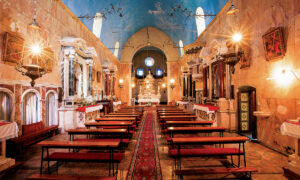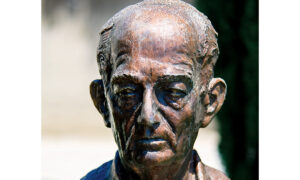Cultural Heritage
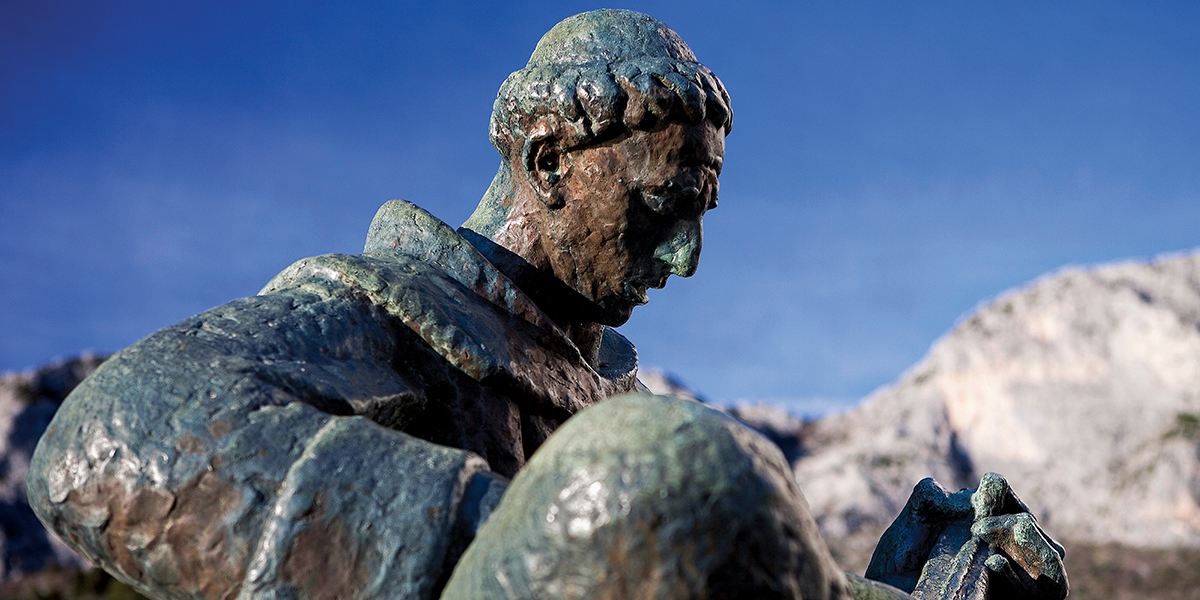
Gradac is the tourist hub of the Municipality of Gradac. Back in the prehistoric era there was an old settlement there, as witnessed by stone blocks from the Bronze and Early Iron Age. During Classical antiquity, a Roman settlement Civitas Biston was at the site of Gradac. It represented a coastal centre of the colony of Narona and an important Roman stronghold in this part of the Adriatic. Copies of Roman coins and a moulding fragment belonging to a monumental building from 2nd or 3rd Century AD were found at Gradina site.
In the Middle Ages, the writings of Byzantine emperor Constantine testify to the old town called Lapčan (Labinetza). Under its present-day name, Gradac was first mentioned in 1649. It comes from a fortress which was located on the hill above today’s Church of St. Michael, built during the War of Candia (1645 -1669). The 1666 drawing of naval and land battles between Venetians and Ottomans in Gradac depicts the fortress set on fire.
The remains of abandoned houses built in traditional architectural style of the region can be found in the deserted village of Čista above Gradac. One of the oldest preserved buildings in the Gradac area is the chapel of St. Pasquale on the Plana hill. Next to the old parish church of St. Anthony is a local graveyard, while the new church dedicated to St. Michael was built in 1852.
The history of the earliest inhabitants of the Brist area is witnessed by the graves dating back to the Bronze and Iron Age. Brist is named after the elm tree (brijest in Croatian), and it was first mentioned in 1571. In the old village there is a baroque church dedicated to St. Margaret, built on the site of an older church which had been torn down.
The remnant of the old church – an apse with a Gothic vault – is embedded in the newer church. The gravestones of the Kačić family can be found there. The remains of an old settlement and stone houses are scattered around the church. According to legend, one of them is the birth house of Friar Andrija Kačić Miošić. Today, Brist is a peaceful centre of family tourism in our area.
Podaca is comprised of three hamlets: Kapeć, Viskovića vala and Ravanje. An archaeological artefact dating back to the Late Stone Age, displayed at the Monastery in Zaostrog, testifies to the first settlements in this area.
The area of Podaca is packed with archaeological artefacts from the Roman times (a shattered jar with a silver coin of the Roman emperor Severus (193- 211 AD), a wall fragment and a stone capital from the Middle Ages, resembling those found in the early Croatian churches...)
In Podaca, the old Croatian church of St. John with the Kačić family graves has survived to this day.
Zaostrog was first mentioned in written documents in 1494, but a granite millstone from the Late Stone Age found on the Viter mountain above Zaostrog testifies to old civilizations. Many ancient monuments in the area of Zaostrog witness the Roman times (the relief of dancers and flute players in the traditional Illyrian costumes, the relief of god Mitra as well as two gravestones).
Following the arrival of Croats, the old settlement was named Ostrog. In 950, the Byzantine emperor Constantine mentions it as one of the four fortified towns in the Principality of Pagania (Mokrun, Berulia, Ostrog, Labinetza). The medieval fortress of Ostrog was located high in the Šapašnik mountain, and a new settlement – Zaostrog – was later built more to the north. In the 17th century people started to form settlements along the coastline, and after 1962 upper settlements were completely abandoned.
The old village of Zaostrog has three churches: the old Gothic Church of St. Barbara with a cemetery on its ancient surroundings, the Church of St. Roch from the 17th Century, and a newer Church of St. Barbara from 1872. There are also three chapels: the one in the village dedicated to St. Anthony in 1893, a Marian chapel at Kučine built in 1911, and the 1894 chapel of St. Elijah at Prosik.
The most important monument in this area is the Franciscan monastery of St. Mary. According to legend, it was founded in the 14th Century by Augustinians. They abandoned it after the fall of Bosnia in 1463. However, in 1468 it was inhabited by Franciscans from the Franciscan Province of Bosna Srebrena, who have been there ever since. In 1640, an apostolic visitor from Rome declared the monastery in Zaostrog as the most beautiful one in the then province. The 1589 stone inscription above the main entrance to the monastery church was written in Croatian using Bosančica script. At the time, the monastery was a well-known sanctuary included in the list of Marian shrines around the world. It also played a significant role during the Enlightenment period. It housed a primary school, humanistic school, high school, philosophical and theological studies as well as a seminary. Nowadays the monastery houses a rich library containing more than 20 000 books and a large number of archival fonds. The permanent exhibition of artworks by a famous Croatian painter Mladen Veža (1916-2010) is also held there. Among many prominent figures of Croatian culture who lived in Zaostrog are Friar Andrija Kačić Miošić (who died in the monastery) and Friar Ivan Despot. The monastery also houses a botanical garden with over 250 plant species.
In the Middle Ages, the writings of Byzantine emperor Constantine testify to the old town called Lapčan (Labinetza). Under its present-day name, Gradac was first mentioned in 1649. It comes from a fortress which was located on the hill above today’s Church of St. Michael, built during the War of Candia (1645 -1669). The 1666 drawing of naval and land battles between Venetians and Ottomans in Gradac depicts the fortress set on fire.
The remains of abandoned houses built in traditional architectural style of the region can be found in the deserted village of Čista above Gradac. One of the oldest preserved buildings in the Gradac area is the chapel of St. Pasquale on the Plana hill. Next to the old parish church of St. Anthony is a local graveyard, while the new church dedicated to St. Michael was built in 1852.
The history of the earliest inhabitants of the Brist area is witnessed by the graves dating back to the Bronze and Iron Age. Brist is named after the elm tree (brijest in Croatian), and it was first mentioned in 1571. In the old village there is a baroque church dedicated to St. Margaret, built on the site of an older church which had been torn down.
The remnant of the old church – an apse with a Gothic vault – is embedded in the newer church. The gravestones of the Kačić family can be found there. The remains of an old settlement and stone houses are scattered around the church. According to legend, one of them is the birth house of Friar Andrija Kačić Miošić. Today, Brist is a peaceful centre of family tourism in our area.
Podaca is comprised of three hamlets: Kapeć, Viskovića vala and Ravanje. An archaeological artefact dating back to the Late Stone Age, displayed at the Monastery in Zaostrog, testifies to the first settlements in this area.
The area of Podaca is packed with archaeological artefacts from the Roman times (a shattered jar with a silver coin of the Roman emperor Severus (193- 211 AD), a wall fragment and a stone capital from the Middle Ages, resembling those found in the early Croatian churches...)
In Podaca, the old Croatian church of St. John with the Kačić family graves has survived to this day.
Zaostrog was first mentioned in written documents in 1494, but a granite millstone from the Late Stone Age found on the Viter mountain above Zaostrog testifies to old civilizations. Many ancient monuments in the area of Zaostrog witness the Roman times (the relief of dancers and flute players in the traditional Illyrian costumes, the relief of god Mitra as well as two gravestones).
Following the arrival of Croats, the old settlement was named Ostrog. In 950, the Byzantine emperor Constantine mentions it as one of the four fortified towns in the Principality of Pagania (Mokrun, Berulia, Ostrog, Labinetza). The medieval fortress of Ostrog was located high in the Šapašnik mountain, and a new settlement – Zaostrog – was later built more to the north. In the 17th century people started to form settlements along the coastline, and after 1962 upper settlements were completely abandoned.
The old village of Zaostrog has three churches: the old Gothic Church of St. Barbara with a cemetery on its ancient surroundings, the Church of St. Roch from the 17th Century, and a newer Church of St. Barbara from 1872. There are also three chapels: the one in the village dedicated to St. Anthony in 1893, a Marian chapel at Kučine built in 1911, and the 1894 chapel of St. Elijah at Prosik.
The most important monument in this area is the Franciscan monastery of St. Mary. According to legend, it was founded in the 14th Century by Augustinians. They abandoned it after the fall of Bosnia in 1463. However, in 1468 it was inhabited by Franciscans from the Franciscan Province of Bosna Srebrena, who have been there ever since. In 1640, an apostolic visitor from Rome declared the monastery in Zaostrog as the most beautiful one in the then province. The 1589 stone inscription above the main entrance to the monastery church was written in Croatian using Bosančica script. At the time, the monastery was a well-known sanctuary included in the list of Marian shrines around the world. It also played a significant role during the Enlightenment period. It housed a primary school, humanistic school, high school, philosophical and theological studies as well as a seminary. Nowadays the monastery houses a rich library containing more than 20 000 books and a large number of archival fonds. The permanent exhibition of artworks by a famous Croatian painter Mladen Veža (1916-2010) is also held there. Among many prominent figures of Croatian culture who lived in Zaostrog are Friar Andrija Kačić Miošić (who died in the monastery) and Friar Ivan Despot. The monastery also houses a botanical garden with over 250 plant species.
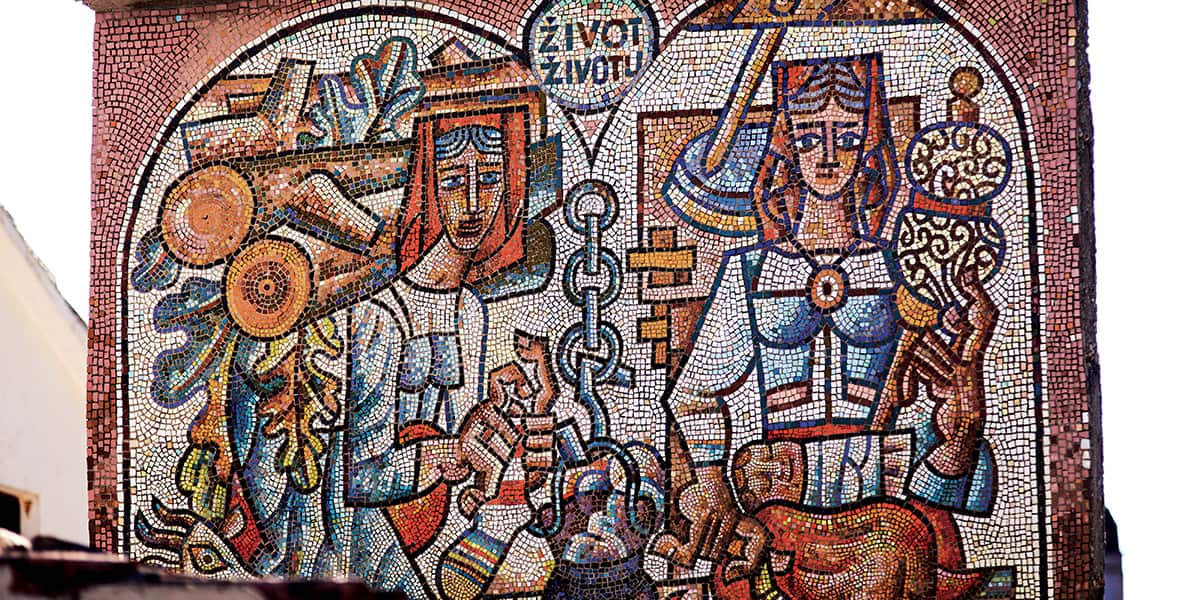
Mladen Veža's artistic legacy - Mosaic Life to Life, Brist Foto: Dario Žagar
Museums and monuments
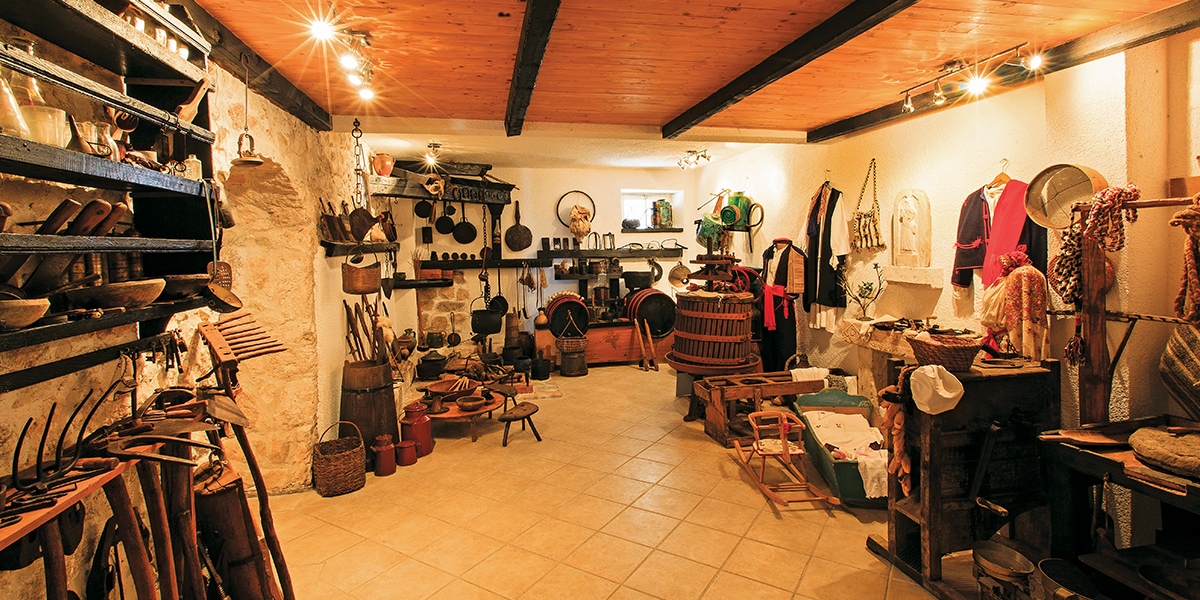
Gradac Local History Collection
The Gradac Local History Collection has been amassed thanks to the years-long effort of its owners – the Andrijašević family. The collected items belonged to the vernacular culture of the Vrgorac region and the Upper Makarska coast as well as to its middle-class residents – the families of seafarers, expatriates and fishermen. The items were used in everyday life during the 19th and the first half of the 20th Century.
Contact:ivana.andrijasevic@gmail.com
021 697 561
The Franciscan monastery in Zaostrog
The collection of ethnographic items in the Franciscan monastery
Zaostrog monastery hosts several valuable collections, including the ethnographic one whose major part has been displayed. It presents the everyday life of the Makarska coastal region.
The archives of the Franciscan monastery
The archives of the Franciscan monastery contain books and manuscripts on the history of the monastery and cultural and economic circumstances of the region. The books date from 1468 to 1929.
Contact: josip.bebicfra@gmail.com and branko.brnas@gmail.com
+385-21-629-200
The Church of St. Margaret in Brist
The church was built in 1751 at the site of the old church which had been torn down. The remnant of the old church – an apse with a Gothic vault – is embedded in a newer church. The church was renovated in 1986. In front of the church is the first of three original mouldings of the sculpture of Andrija Kačić Miošić. It is the work of one of the greatest Croatian artists, a world-famous sculptor Ivan Meštrović.
The Birthplace of Friar Andrija Kačić Miošić
A two-storey residential building of rectangular floor plan, partially buried in the ground, was built above the village of Brist. Typologically the house belongs to the fortified residential houses of the Makarska coastal region. It is also a memorial. Namely, the eminent Croatian poet and enlightener Friar Andrija Kačić Miošić was born there in 1704, as witnessed by the memorial plaque from 1934 on the southern facade of the house.
The art legacy of Mladen Veža
One of the most prominent Croatian artists of the 20th Century, painter and sculptor Mladen Veža, was born in Brist, to which he dedicated most of his oeuvre. The permanent exhibition of his paintings is held at the Monastery in Zaostrog, while his mosaic named Life is located in the centre of Brist.
The complex of houses on the coast
The complex of houses on the coast consists of three residential and economic buildings with terraces, balconies and vaulted arsenals in their ground floor. Based on their construction properties and late baroque stylistic features, the houses can be dated to the 18th Century. A series of loopholes has been preserved there, designed to defend against pirates. The complex of houses neatly combines residential-economic functions with stylistic decoration and countryside-villa atmosphere. According to legend, Friar Andrija Kačić Miošić stayed in one of those houses.
Primary school building
The Brist primary school building was erected in 1878 by the decree of the Dalmatian Parliament in the memory of Friar Andrija Kačić Miošić, as witnessed by the plaque on its southern facade. It belongs to the oldest school buildings in Dalmatia and it has played a significant role in the education of the local population ever since the time of the Croatian National Revival in the mid-19th Century. Nowadays, the Brist branch school operates in the building, and in the summer, the Tourist Board's info office is located there.
The Church of St. John in Podaca
The church was built in the old village of Podaca. A single-nave structure belongs to the Pre-Romanesque period, and it is built in the 11th-12th Century.
The tower in Podaca
At the eastern entrance to the village of Podaca, a tower with a small defensive wall underneath it was built to defend against the Ottomans. Its oldest depiction dates back to 1666. The tower of irregular floor plan was built using quarried stone and mortar. It has not been preserved at its full height.
Protected rural area of the old village of Podaca
Podaca is situated on the slopes of the Biokovo Mountain in the upper Makarska coastal region. Its location was suitable for protection against potential enemies. On the steep cliffs in the south-eastern part of the village is a tower from the 17th Century. The main meeting point of the locals is Štrada, a square in the middle of the village next to the church. The village has two churches: the Church of St. John dating back to the 12th-13th Century and a baroque parish church from the 18th Century. Archaeological artefacts from the Late Stone Age, Illyrian period, Roman times and early Croatian period have been found in Podaca.
The Church of St. Barbara
The Church of St. Barbara at the cemetery is also known in sources as the Church of St. Bara, the Old Church of St. Barbara, the Gravesite Church and the Old Parish Church. It was built during the Gothic period below the old village and acted as a parish church. A 1765 triptych by F. Naldi had been placed in the church. It was restored in the 1990s and added to the collection of the Franciscan monastery on the shore. Nowadays the church houses a simple stone altar and a relatively recent oil painting The Entombment of Christ.
Art today
Podaca - Art Colony - ASSOCIATION FOR THE PROMOTION AND PROTECTION OF THE ANTIQUITES OF PODACA VILLAGE "ŠTRADA"
Podaca - Tonći Alač, visual artist
Gradac - Teo Bilas - artist, painter and sculptor
Gradac - Adna Bakija Stanković, visual artist, sculptress, street art
Gradac - klapa group "Viola" and women's singing choir "Gradac", men's klapa group "Kačić"
The Gradac Local History Collection has been amassed thanks to the years-long effort of its owners – the Andrijašević family. The collected items belonged to the vernacular culture of the Vrgorac region and the Upper Makarska coast as well as to its middle-class residents – the families of seafarers, expatriates and fishermen. The items were used in everyday life during the 19th and the first half of the 20th Century.
Contact:ivana.andrijasevic@gmail.com
021 697 561
The Franciscan monastery in Zaostrog
The collection of ethnographic items in the Franciscan monastery
Zaostrog monastery hosts several valuable collections, including the ethnographic one whose major part has been displayed. It presents the everyday life of the Makarska coastal region.
The archives of the Franciscan monastery
The archives of the Franciscan monastery contain books and manuscripts on the history of the monastery and cultural and economic circumstances of the region. The books date from 1468 to 1929.
Contact: josip.bebicfra@gmail.com and branko.brnas@gmail.com
+385-21-629-200
The Church of St. Margaret in Brist
The church was built in 1751 at the site of the old church which had been torn down. The remnant of the old church – an apse with a Gothic vault – is embedded in a newer church. The church was renovated in 1986. In front of the church is the first of three original mouldings of the sculpture of Andrija Kačić Miošić. It is the work of one of the greatest Croatian artists, a world-famous sculptor Ivan Meštrović.
The Birthplace of Friar Andrija Kačić Miošić
A two-storey residential building of rectangular floor plan, partially buried in the ground, was built above the village of Brist. Typologically the house belongs to the fortified residential houses of the Makarska coastal region. It is also a memorial. Namely, the eminent Croatian poet and enlightener Friar Andrija Kačić Miošić was born there in 1704, as witnessed by the memorial plaque from 1934 on the southern facade of the house.
The art legacy of Mladen Veža
One of the most prominent Croatian artists of the 20th Century, painter and sculptor Mladen Veža, was born in Brist, to which he dedicated most of his oeuvre. The permanent exhibition of his paintings is held at the Monastery in Zaostrog, while his mosaic named Life is located in the centre of Brist.
The complex of houses on the coast
The complex of houses on the coast consists of three residential and economic buildings with terraces, balconies and vaulted arsenals in their ground floor. Based on their construction properties and late baroque stylistic features, the houses can be dated to the 18th Century. A series of loopholes has been preserved there, designed to defend against pirates. The complex of houses neatly combines residential-economic functions with stylistic decoration and countryside-villa atmosphere. According to legend, Friar Andrija Kačić Miošić stayed in one of those houses.
Primary school building
The Brist primary school building was erected in 1878 by the decree of the Dalmatian Parliament in the memory of Friar Andrija Kačić Miošić, as witnessed by the plaque on its southern facade. It belongs to the oldest school buildings in Dalmatia and it has played a significant role in the education of the local population ever since the time of the Croatian National Revival in the mid-19th Century. Nowadays, the Brist branch school operates in the building, and in the summer, the Tourist Board's info office is located there.
The Church of St. John in Podaca
The church was built in the old village of Podaca. A single-nave structure belongs to the Pre-Romanesque period, and it is built in the 11th-12th Century.
The tower in Podaca
At the eastern entrance to the village of Podaca, a tower with a small defensive wall underneath it was built to defend against the Ottomans. Its oldest depiction dates back to 1666. The tower of irregular floor plan was built using quarried stone and mortar. It has not been preserved at its full height.
Protected rural area of the old village of Podaca
Podaca is situated on the slopes of the Biokovo Mountain in the upper Makarska coastal region. Its location was suitable for protection against potential enemies. On the steep cliffs in the south-eastern part of the village is a tower from the 17th Century. The main meeting point of the locals is Štrada, a square in the middle of the village next to the church. The village has two churches: the Church of St. John dating back to the 12th-13th Century and a baroque parish church from the 18th Century. Archaeological artefacts from the Late Stone Age, Illyrian period, Roman times and early Croatian period have been found in Podaca.
The Church of St. Barbara
The Church of St. Barbara at the cemetery is also known in sources as the Church of St. Bara, the Old Church of St. Barbara, the Gravesite Church and the Old Parish Church. It was built during the Gothic period below the old village and acted as a parish church. A 1765 triptych by F. Naldi had been placed in the church. It was restored in the 1990s and added to the collection of the Franciscan monastery on the shore. Nowadays the church houses a simple stone altar and a relatively recent oil painting The Entombment of Christ.
Art today
Podaca - Art Colony - ASSOCIATION FOR THE PROMOTION AND PROTECTION OF THE ANTIQUITES OF PODACA VILLAGE "ŠTRADA"
Podaca - Tonći Alač, visual artist
Gradac - Teo Bilas - artist, painter and sculptor
Gradac - Adna Bakija Stanković, visual artist, sculptress, street art
Gradac - klapa group "Viola" and women's singing choir "Gradac", men's klapa group "Kačić"
- The bell tower of the church of Sv. Ivana in Podaca, Photo: Dario Žagar
- The bell tower of the church of Sv. Ivana in Zaostrog, Photo: Dario Žagar
- Famous Croatian poet Srećko Diana, sculpture in Brist, Photo: Dario Žagar


